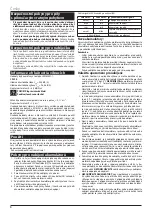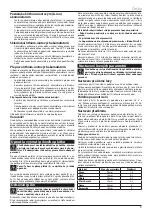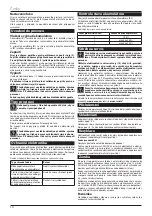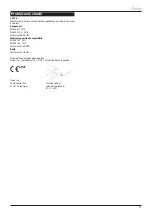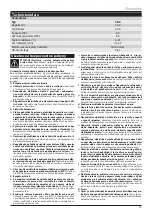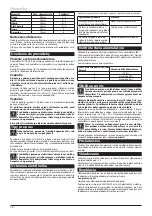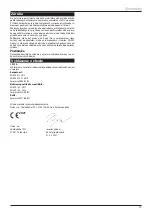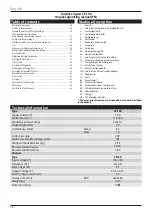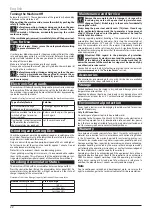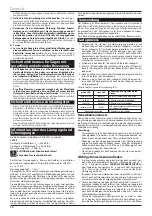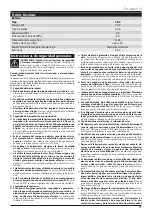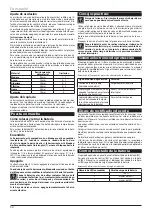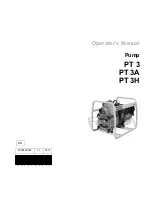
English
21
Transporting lithium-ion batteries
As per legal regulation, lithium-ion batteries fall into the hazardous load
category. These batteries must be transported while complying with lo-
cal, national, as well as international guidelines and regulations.
• Consumers may transport these batteries on public roads without
a problem.
• Commercial transportation of lithium-ion batteries by transpor-
tation companies must comply with the regulation on hazardous
load transportation. Only trained personnel may carry out the
preparation and the actual transport. The entire process must have
expert supervision.
The following must be maintained during battery transportation:
• Make sure that contacts are protected and isolated to prevent
a short circuit.
• Be careful so that a large number of batteries do not move around
or fall and collapse during transport.
• Damaged and leaking batteries cannot be transported.
Please contact your carrier for additional information.
Warning!!
It is not expected for the user to perform any service repairs on the
charger. There are no spare parts inside the charger, which users could
repair on their own. It is necessary to bring the charger to your nearest
authorised service centre to prevent damage to spare parts, which are
sensitive to static electricity, for example.
Always use the right set of batteries (the set delivered with the tools or
a replacement set recommended by Narex s.r.o.). Never use any other
sets of accumulator batteries because they could damage your tools and
cause a hazardous situation.
Mounting and Removing a Saw Blade
Before transporting, storing or doing any work on the pow-
er tool (e.g., maintenance, change of tools), remove the
accumulator. Otherwise, accidentally pressing the switch
could cause injury.
To mount a saw blade (6), swing out the clamping lever (5) fully and
then slide the saw blade (6) all the way into the saw blade clamp (3)
with your other hand. Then, release your hold of the clamping lever (5).
It is fitted with a spring that pulls it back to the body of the machine.
Attention! Pull on the saw blade (6) to check that it is se-
curely fastened.
To remove the saw blade (6), swing out the clamping lever (5) fully and
then slide the saw blade (6) out of the saw blade clamp (3) with your
other hand . If you won’t be mounting another saw blade, release the
clamping lever and pull it back to its original position.
Dust Extraction
Attention! Health hazard due to the effects of dust! Dust
can pose a hazard to health; never work with the tool with-
out dust extraction, particularly in enclosed spaces.
Always follow national regulations when extracting hazardous dust.
When extracting dust (sawdust) with an industrial vacuum cleaner, fol-
low the operating instructions for the vacuum cleaner!
Dust from materials such as paint with lead content, certain types of
wood, minerals and metal may be hazardous to health. Contact with
dust or its inhalation may cause allergic reactions and/or respiratory
illnesses to the user or persons located nearby. Some types of dust,
such as oak or beech sawdust, are considered carcinogenic, particularly
when combined with substances for wood treatment (chromate, wood
preservatives).
Materials containing asbestos may only be machined by specialists.
– If possible, use dust extraction suitable for the given type of
material.
– Ensure proper ventilation of the workspace.
– It is recommended to wear a face mask with a P2 filter rating.
Plug the extraction adapter (13) into the extraction hole (8c) on the back
of the saw’s sole plate (8) so that the extraction adapter’s safety (13a)
slots into the safety groove on the sole plate.
Fit the hose of the vacuum cleaner (27 mm hose diameter) onto the end
of the extraction adapter (13).
To detach the extraction adapter (13) from the saw, press the safe-
ty (13a) in the safety groove on the sole plate (8) while simultaneously
pulling the adapter out of the dust extraction hole (8c).
Adjusting Cutting Parameters
Before transporting, storing or doing any work on the pow-
er tool (e.g. maintenance, change of tools), remove the ac-
cumulator. Otherwise, accidentally pressing the switch
could cause injury.
Adjustments for Angled Cuts
The sole plate (8) of the saw can be rotated along the longitudinal axis
by 45° to each side.
Use the arresting lever (9) to release the sole plate (8). Slide the sole
plate (8) to the centre of the guiding groove for positioning and rotate
the plate to the angle of choice (there is a scale on the sole plate for
indication). Then use the arresting lever (9) to secure the sole plate at
this angle.
Longitudinal Adjustment of the Sole Plate
The sole plate (8) can be adjusted along the longitudinal axis to an an-
gle of -45°, 0° and +45°. Use the arresting lever (9) to release the sole
plate (8). Slide the sole plate forward or back. Then use the arresting
lever (9) to secure the sole plate in position.
Pendulum Action Settings
Pendulum action is created by the synchronous horizontal movement of
the guide roller (4) and the pull bar up and down. When moving down,
the saw blade moves away from the material. This facilitates removal
of chips from the cut, reduces heat generation through friction and ex-
tends the service life of the saw blade.
The parameters of pendulum action can be adjusted using the pendu-
lum action switch (7) to four levels,
0–3
, where setting the switch to
0
deactivates pendulum action and
3
sets it to maximum.
Instructions for settings:
When machining thin materials, such as metal sheets, or hard materials
such as ceramic, set pendulum action to zero.
Setting low or zero pendulum action ensures cleaner edges of the cut
in soft materials.
For mostly soft materials, such as wood or plastic, you can work with
more pronounced pendulum action.
When cutting curves or arcs in soft materials, set zero or low pendulum
action depending on the curvature so that lower pressure and stress is
placed on the saw blade.
It is advised to check that the pendulum action setting is suitable by
making a test cut. Approximate information for pendulum action set-
tings are available in the Pendulum Action Setting table.
Material
Max. material
thickness
Pendulum action
Wood
90 mm
1–3
Steel
10 mm
0–1
Aluminium
20 mm
0–2
Plastic
20 mm
0–2
Rubber
30 mm
0
Ceramic
10 mm
0
Air Blasting Setting
The machine allows for air blasting (cleaning) of the work space (point
of cut). Use the air blasting lever (10) to deactivate air blasting or set it
to three different levels.
If you are extracting saw dust through a connected vacuum cleaner, turn
air blasting off.
Starting the Machine
Inserting and Removing the Accumulator
Slide the accumulator (B1) all the way into the shaft on the back of the
machine’s handle. Pull on the accumulator to make sure it is fitted prop-
erly.
To remove the accumulator (B1) from the machine, push on the accumu-
lator clamp (B2) and pull the accumulator out.
Turning the Machine On
The machine is fitted with a safety device to prevent an accidental
start (2). The safety is locked when it is pushed to the right when
looking from the rear of the machine. To unlock the machine’s on
switch (1), push the safety to the left.
Pressing the switch (1) and gradually pushing on it regulates speed.
Pressing the switch (1) automatically activates LED lighting (11) to illu-
minate the space around the cut.
Summary of Contents for CPL 90
Page 4: ...4 B4 B5 B3 B2 B1 12 13a 1 2 B3 8b 4 14 3 11 5 8a 6 2 1 7 8b 8a 5 8 8c 13 9 7 15 9 8...
Page 5: ...5 2 1 10 4 9 15 B2 8b 3 11 8a B1 N2 N1...
Page 49: ...o 49 1 2 a RCD RCD 3 a 4 a CB 4 20 0 Li Ion 4 0 80 C 0 45 60 0 67...
Page 51: ...o 51 2 0 C 45 C 3 4 5 6 7 8 9 Li Ion 5 C 40 C 6 5 6 3 5 6 6 5 6 3...


